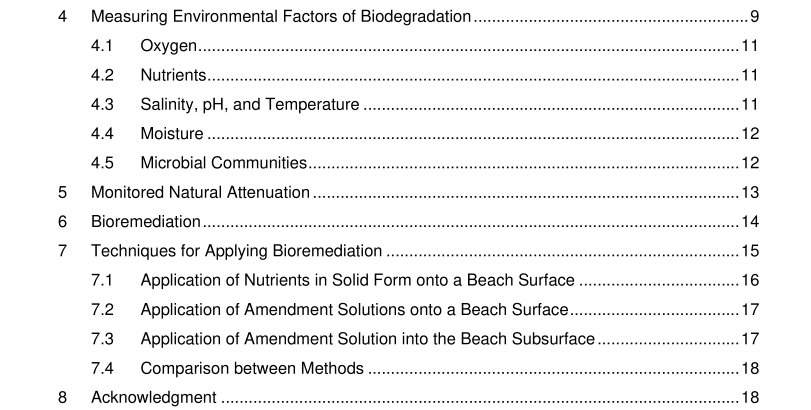API TR 1147:2014 pdf free download.Biodegradation and Bioremediation of Oiled Beaches A Primer for Planners and Managers
Oil is made up of thousands of chemicals that can be placed into four groups: saturates, aromatics, resins, and asphaltenes (referred to as SARA). “Light oil” generally contains more saturates and aromatics, while “heavy oil” contains more resins and asphaltenes. However, for most crude oils, the saturates and aromatics make up a larger portion of the entire composition on a mass basis.
The physical, chemical, and biological properties of these components dictate their overall environmental fate in an oil spill situation. Understanding the conceptual model of the environmental fate of oil under natural conditions provides a basis for decision makers to develop response plans for shorelines impacted by an offshore release. While physical/mechanical removal is the primary response action for addressing the bulk oil deposited on shorelines, natural attenuation (the combination of hydraulic flushing and biodegradation) and the applicability of bioremediation of the oil would still need to be considered for three non-exclusive reasons:
1 . There are land owners who refuse to allow the usage of mechanical means to remove the oil,
2. Some patches of oil are likely to be missed by physical removal approaches, especially when dealing with large distances of impacted shorelines, and
3. Any protocol to physically remove oil has end-points beyond which additional physical action would not result in a net environmental benefit (as determined through a Net Environmental Benefits Analysis, NEBA). Therefore, the goal of this manuscript is to provide guidelines for understanding the natural attenuation processes and subsequently, whether applying bioremediation would provide any additional benefits or challenges to cleaning up oiled shorelines.
For the purposes of this document, a “beach” is defined as the soil or sediment matrix of a “shoreline” that may or may not contain vegetation rooted in the matrix. Within a beach, fluids can move in and out within the pore spaces between sediment particles (known as the “pore water” space) and is measured as the “permeability” of the sediment. In general, larger sized sediments have higher permeability than finer-grained materials. When oil moves into the sediment matrix, it is “deposited”, and when it is moved out by water, this is known as “hydraulic flushing”.
The ease with which oil moves in or out is called the “oil hydraulic conductivity”. Similarly, water also moves in and out of the pore spaces and is termed the “water hydraulic conductivity”. While permeability is a function of the sediment matrix, the hydraulic conductivity depends on the pore space geometry, the fluid, and the content of that fluid in the pore space. Thus, oil and water do not behave the same way in the pore space.
Oil present in a shoreline is amenable to processes of “biodegradation”, which refers to the natural breakdown by microorganisms into more elementary compounds. Biodegradation occurs provided the necessary conditions to promote it are met, and it can occur either in aerobic conditions (in the presence of oxygen) or anaerobic conditions (in the absence of oxygen). Typically, substantial biodegradation requires the presence of certain mineral conditions for the microorganisms to flourish. A key piece of information for decision-making is the rate of biodegradation (i.e., how fast oil components break down). For instance, it would be important for a manager or planner to know whether a component will deplete to 1 0% of its original mass in one month or in 1 0 years.
To accelerate the rate of natural biodegradation, decision makers can consider “bioremediation” as a standalone or supplemental response action. Two major categories of bioremediation are “biostimulation”,which refers to the addition of nutrients or oxygen to stimulate indigenous oil-degrading microorganisms,and “bioaugmentation”, which refers to the addition of microorganisms with desirable catabolic traits.API TR 1147 pdf download.API TR 1147:2014 pdf free download
